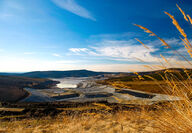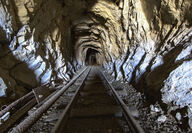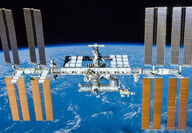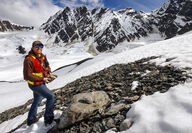Sorted by date Results 326 - 350 of 518

Graphite One Inc. Sept. 23 announced the start of a fall drill program at its Graphite Creek property located near Nome, Alaska. The roughly 800 meters of planned drilling will provide geotechnical information for an open-pit mine design and determine ground conditions in proposed infrastructure sites in preparation for the completion of a prefeasibility study for developing a mine at Graphite Creek, slated for the second quarter of next year. "Our 2019 drilling program is exp...

Ucore Rare Metals Inc. Sept. 23 reported two developments that could bolster the economics of a mine at Bokan-Dotson Ridge and expedite the permitting of this potential rare earth operation in Southeast Alaska. The potential boost in economics comes from a recent study that beryllium, zirconium, niobium, and hafnium could be valuable by-products to mining the rare earth elements at Bokan Mountain. All four of these metals are on the U.S. Geological Survey list of minerals cons...

Graphite One Inc. Sept. 9 announced it has secured the funding to finalize a prefeasibility study for its Graphite Creek project in western Alaska. Taiga Mining Company Inc., an Alaska-based company that is a major Graphite One shareholder, has agreed to loan Graphite One US$4.8 million for the advanced engineering and economic study for developing a graphite mine and processing facility. "In our current challenging capital markets, a commitment of US$4.8 million – which is ex...

Ucore Rare Metals Inc. has unveiled a three-tier strategy for delivering a non-Chinese source of rare earth elements to North American markets from its Bokan Mountain project in Alaska. Called M3, for mines, metals and markets, Ucore's plan to meet the needs of an independent rare earth supply chain in the United States includes three initiatives: advancing its Bokan-Dotson Ridge rare earths project in Southeast Alaska to shovel-ready status; developing an associated facility...

Nova Minerals Ltd. Sept. 2 said results from this year's drill program at its Estelle gold project in Alaska has cut higher grade, near-surface mineralization within a bulk tonnage gold deposit at Oxide Korbel. Oxide Korbel is a prospect area that roughly covers an area previously referred to as Oxide Ridge toward the north end of the roughly 18-mile-long Estelle property. SE11-01, the Oxide Ridge discovery hole drilled by Millrock Resources Inc. in 2011, cut 450.7 meters...

United States Bureau of Land Management Aug. 30 published the Draft Environmental Impact Statement for the proposed Ambler Mining District Industrial Access Road to the Federal Register, marking the official start of a 45-day public comment period for this proposed 211-mile transportation corridor to one of the richest undeveloped minerals districts in Alaska. Alaska Industrial Development and Export Authority, which is expected to build and maintain the Ambler road and be...

Ucore Rare Metals Inc. Aug. 29 reported that Alaska Gov. Michael Dunleavy has asked the White House to designate Bokan-Dotson Ridge rare earth project as a high priority infrastructure project, which would expedite the permitting process for this potential critical metals mine in Southeast Alaska. "The state of Alaska understands the critical nature of a secure supply chain for rare earth minerals in the United States. We are seeking your support to have this Alaskan rare...

The Koniag Inc. region covers the Kodiak Archipelago, a group of islands off the southern coast of mainland Alaska better known for their enormous brown bears than vast mineral potential. The Alutiiq people that arrived on Kodiak, Afognak and surrounding islands more than 7,500 years ago were skilled mariners who were deeply connected to the ocean for food and supplies. Over the millennia, these roaming seafarers settled into whaling and fishing villages that sheltered...

In the westernmost reaches of Alaska lies "Tin City," a mining settlement that all but disappeared except for a lonely radar station looking out over our seas and skies today. Located on the Seward Peninsula's Bering Sea coast, about 90 miles northwest of Nome and five miles southeast of Cape Prince of Wales, Tin City was founded with aspirations as simple and as grand as the name had hoped for it. An all but forgotten camp that had implications far larger than it probably...

With the issuance of five presidential determinations related to the domestic production of rare earth metals and magnets, President Donald Trump is making it clear the White House sees this group of 17 technology elements as essential to the security of the United States. In five memos sent to the secretary of defense on July 22, Trump made an official determination under Section 303 of the Defense Production Act of 1950 that domestic production, separation and manufacturing...

Washington D.C.'s increased interest in securing a steadfast supply of critical minerals may prompt further advancement at Ucore Rare Metals Inc.'s Bokan Mountain, a Southeast Alaska project that hosts seven of the 35 minerals, metals and groups of elements that are considered critical to the United States. A federal interagency report published earlier this month by the U.S. Department of Commerce, "A federal strategy to ensure secure and reliable supplies of critical...

Nova Minerals Ltd. June 3 said it is looking into the potential of selling or bringing on a partner to advance exploration of its Windy Fork rare earth elements (REE) project in Southwest Alaska. During recent meeting in New York City, Nova directors received strong interest in Windy Creek and the placer REE occurrences identified on the property. Bulk sampling at Windy Fork in the 1990s indicates that the placer deposit there contains roughly 17 million cubic meters of...

Constantine Metal Resources Ltd. June 3 released a preliminary economic assessment for Palmer that outlines an economically robust and environmentally conscientious mine for the volcanogenic massive sulfide project in Southeast Alaska. "This PEA is the most significant milestone for Constantine to date, demonstrating a high-quality project with strong economics and a progressive, environmentally conscious mine design," said Constantine Metal Resources President and CEO...

The U.S. Department of Commerce June 4 released "A federal strategy to ensure secure and reliable supplies of critical minerals," an interagency report that outlines a government-wide action plan to ensure the United States has secure and reliable supplies of critical minerals. Department of Commerce was charged with spearheading this report under Executive Order 13817, which was signed by President Donald Trump late in 2017. Trump's critical minerals executive order...

Since the stampedes of prospectors trekked North in the latter half of the 19th Century, the lure of Alaska's rich gold lodes has drawn dreamers and miners North. Today, four hardrock mines and hundreds of family-run placer operations across the Last Frontier churn out roughly 1 million ounces of this alluring precious metal each year – and the largest stores of aurum discovered here have yet to be realized. Despite being a relatively rare metal that has served as a c...

Antimony is a poor conductor of heat, an attribute that lends itself to this semi-metal's most common use, as an ingredient to make clothing, mattresses and other products flame resistant. While making work clothes and household items safer and less likely to catch fire is a relatively new use for antimony, humans have been using antimony for other purposes for more than 5,000 years. "For example, the ancient Egyptians and early Hindus used stibnite, which is the major ore...

Titanium conjures images of the durable and lightweight metal used to build aircraft, replacement hips, high-end bicycle frames and even quality golf clubs. While its outstanding weight-to-strength ratio and corrosion resistance makes this critical metal ideal for these applications, roughly 93 percent of the world's titanium is used to impart a stark whiteness to many of the consumer goods we use every day. "Titanium is different than most other metallic elements in that it...

Zirconium and hafnium are closely related elements that share bonds that tie them together in nature, an affinity that carries over into their industrial applications. "Zirconium and hafnium are metals that are used in the chemical and nuclear-reactor industries in applications for which corrosion resistance, structural stability at high temperatures, and specific alloying properties and (or) specific neutron-absorption characteristics are required," the United States...

The six platinum group elements – platinum, palladium, rhodium, ruthenium, iridium, and osmium – are amongst the rarest metals on Earth. This scarcity, coupled with PGEs' uses in the automotive, petrochemical and electronics industries, has this group of industrious precious metals firmly planted on the United States Geological Survey's critical minerals list. "PGEs are indispensable to many industrial applications but are mined in only a few places," USGS inked in a 2017 rep...

A vital ingredient in stainless steel and superalloys, chromium is considered by the United States Geological Survey as "one of the nation's most important strategic and critical materials." "Because there is no viable substitute for chromium in the production of stainless steel and because the United States has small chromium resources, there has been concern about domestic supply during every national military emergency since World War I," the USGS explains. Rich chromite...

At least 125 million electric vehicles are expected to be traveling global highways by 2030, which means the world is going to need a lot more graphite in the coming decade and beyond. This is because graphite serves as the anode in the lithium-ion batteries that power these EVs, not to mention the growing number of portable tools and electronics that use the same type of battery. According to Mineral Commodity Summaries 2019, an annual report published by the United States...

In addition to being a past producer and a future source of most of the 35 minerals and metals considered critical to the United States, Alaska currently contributes a globally significant amount of one of these vital metals – germanium. While not a widely known metal, germanium has optical qualities that make it an important ingredient in fiber-optics, infrared optics, electronics and solar energy systems. "The extensive use of germanium for military and commercial a...

If you are reading this article on your computer, tablet or phone, you are almost certainly looking through indium as we speak; and, if that devise happens to be a touchscreen you have the unique properties of this critical mineral to thank as you scroll down to read more about indium and where it can be found in Alaska. This is because indium-tin oxide is used as a transparent conducting film applied to virtually every flat-panel display and touchscreen on the market. This...

While not the flashiest of the 35 minerals on the United States Geological Survey's critical list, barite plays an essential role in America's energy sector. Barite derives its name from barús, the Ancient Greek word for heavy, owing to an exceptionally high specific gravity for a non-metallic mineral. It is this weight that makes barite a key element to the oil and gas sector and lands the mineral on USGS' critical list. "More than 90 percent of the barite sold in the United...

Cobalt is a critical safety ingredient in the cathodes of lithium-ion batteries powering the ever-increasing number of electric vehicles traveling global highways and a plethora of cordless electrical devices. "Globally, the leading use is in the manufacture of cathode materials for rechargeable batteries – primarily lithium-ion, nickel-cadmium, and nickel-metal-hydride batteries – which are used in consumer electronics, electric and hybrid-electric vehicles, energy sto...